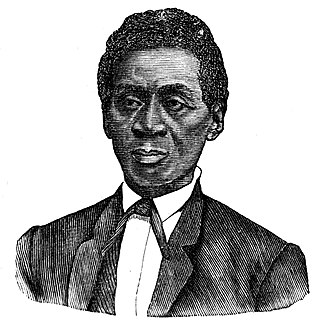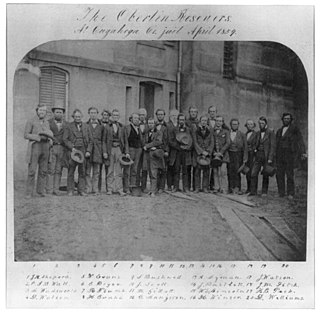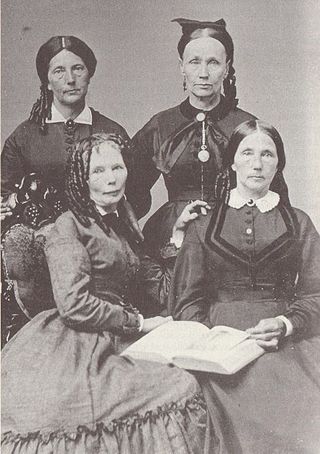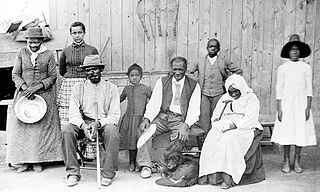Related Research Articles

Denton is a town in Caroline County, Maryland, United States. The population of Denton was 4,418 as of the 2010 United States Census, and it is the county seat of Caroline County.

The Fugitive Slave Act or Fugitive Slave Law was a law passed by the 31st United States Congress on September 18, 1850, as part of the Compromise of 1850 between Southern interests in slavery and Northern Free-Soilers.

Silas Stillman Soule was an American abolitionist, military officer and 'conductor' on the Underground Railroad. As a Kansas Jayhawker, he supported and was a proponent of John Brown's movement in the time of strife leading up to the American Civil War.

Patty Cannon, whose birth name may have been Lucretia Patricia Hanly, was an illegal slave trader, serial killer, and the co-leader of the Cannon–Johnson Gang of Maryland–Delaware. The group operated for about a decade in the early 19th century and abducted hundreds of free Black people and fugitive slaves, along the Delmarva Peninsula, across multiple state lines to sell into slavery in southern states such as Alabama and Mississippi. The activity became known as the Reverse Underground Railroad.

Passmore Williamson was an American abolitionist and businessman in Philadelphia, Pennsylvania, a free state in the antebellum years. As secretary of the Pennsylvania Anti-Slavery Society and a member of its Vigilance Committee, Williamson is best known for helping Jane Johnson and her two sons gain freedom from slavery on July 18, 1855.

Samuel Green was a slave, freedman, and minister of religion. A conductor of the Underground Railroad, he was tried and convicted in 1857 of possessing a copy of the anti-slavery novel Uncle Tom's Cabin by Harriet Beecher Stowe following the Dover Eight incident. He received a ten-year sentence, and was pardoned by the Governor of Maryland Augustus Bradford in 1862, after he served five years.

The Oberlin–Wellington Rescue of 1858 in was a key event in the history of abolitionism in the United States. A cause celèbre and widely publicized, thanks in part to the new telegraph, it is one of the series of events leading up to Civil War.

Joshua Glover was a fugitive slave who escaped from the United States to Canada in the 1850s. His escape from recapture was part of the chain of events that led to the Civil War and the end of slavery in the U.S.

Samuel D. Burris was a member of the Underground Railroad. He had a family, who he moved to Philadelphia for safety and traveled into Maryland and Delaware to guide freedom seekers north along the Underground Railroad to Pennsylvania.

Marietta is a historic house and former tobacco plantation located in Glenn Dale, Prince George's County, Maryland. On the National Register of Historic Places and the National Underground Railroad Network to Freedom, Marietta House Museum includes a federal era house, a cemetery, the original root cellar, and harness room, as well as Judge Gabriel Duvall's original law office building. The historic site sits on 25 acres of Marietta's original 690 acres. Today, visitors can walk the grounds and tour the plantation buildings and sites where free and enslaved people lived and labored.

The Underground Railroad in Indiana was part of a larger, unofficial, and loosely-connected network of groups and individuals who aided and facilitated the escape of runaway slaves from the southern United States. The network in Indiana gradually evolved in the 1830s and 1840s, reached its peak during the 1850s, and continued until slavery was abolished throughout the United States at the end of the American Civil War in 1865. It is not known how many fugitive slaves escaped through Indiana on their journey to Michigan and Canada. An unknown number of Indiana's abolitionists, anti-slavery advocates, and people of color, as well as Quakers and other religious groups illegally operated stations along the network. Some of the network's operatives have been identified, including Levi Coffin, the best-known of Indiana's Underground Railroad leaders. In addition to shelter, network agents provided food, guidance, and, in some cases, transportation to aid the runaways.

John Hossack was a Scottish-American abolitionist whose home, John Hossack House, was a "station" on the Underground Railroad. He gained notoriety in 1860 when he was tried and convicted for violating the Fugitive Slave Law of 1850 by helping Jim Gray, an African American, avoid slave catchers.
William Parker was an American former slave who escaped from Maryland to Pennsylvania, where he became an abolitionist and anti-slavery activist in Christiana. He was a farmer and led a black self-defense organization. He was notable as a principal figure in the Christiana incident, 1851, also known as the Christiana Resistance. Edward Gorsuch, a Maryland slaveowner who owned four slaves who had fled over the state border to Parker's farm, was killed and other white men in the party to capture the fugitives were wounded. The events brought national attention to the challenges of enforcing the Fugitive Slave Law of 1850.

Delia Ann Webster was an American teacher, author, businesswoman and abolitionist in Kentucky who, with Calvin Fairbank, aided many slaves, including Lewis Hayden, his wife Harriet, and their son Joseph to escape to Ohio. She was convicted and sentenced to two years in the Kentucky State Penitentiary in Frankfort for aiding the Haydens' escape, but pardoned after two months.


Harriet Tubman (1822 – 1913) was an American abolitionist and political activist. Tubman escaped slavery and rescued approximately 300 enslaved people, including members of her family and friends. Harriet Tubman's family includes her birth family; her two husbands, John Tubman and Nelson Davis; and her adopted daughter Gertie Davis.

The Tilly Escape occurred in October 1856 when an enslaved woman, Tilly, was led by Harriet Tubman from slavery in Baltimore to safety in Philadelphia. Historians who have studied Tubman consider it "one of her most complicated and clever escape attempts." It was a risky trip because Tubman and Tilly would not have been able to travel directly from Baltimore to Philadelphia without proof that they were free women. In addition, local slave traders would have recognized strangers. Tubman sought to evade capture by going south, before heading north, and using different modes of transportation over water and land.
The Dover Eight refers to a group of eight black people who escaped their slaveholders of the Bucktown, Maryland area around March 8, 1857. They were helped along the way by a number of people from the Underground Railroad, except for Thomas Otwell, who turned them in once they had made it north to Dover, Delaware. There, they were lured to the Dover jail with the intention of getting the $3,000 reward for the eight men. The Dover Eight escaped the jail and made it to Canada.
William Brinkley was a conductor on the Underground Railroad who helped more than 100 people achieve freedom by traveling from Camden, Delaware past the "notoriously dangerous" towns of Dover and Smyrna north to Blackbird and sometimes as far as Wilmington, which was also very dangerous for runaway enslaved people. Some of his key rescues include the Tilly Escape of 1856, the Dover Eight in the spring of 1857, and the rescue of 28 people, more than half of which were children, from Dorchester County, Maryland. He had a number of pathways that he would take to various destinations, aided by his brother Nathaniel and Abraham Gibbs, other conductors on the railroad.
Emeline and Samuel Hawkins were a couple from Queen Anne's County, Maryland who had six children together and ran away from Emeline and her children's slaveholders in 1845, with the assistance of Samuel Burris, a conductor on the Underground Railroad. They made it through a winter snowstorm to John Hunn's farm, where they were captured and placed in the New Castle jail. Thomas Garrett interceded and as a result the Hawkins were freed and they settled in Byberry, Philadelphia, Pennsylvania. Two slaveholders, Charles Glanding and Elizabeth Turner, claimed to own Emeline and her six children. Glanding and Turner initiated lawsuits against Hunn and Garrett. Found guilty by a jury primarily made up of slaveholders, Hunn and Garrett were financially devastated by the fines levied against them.
References
Notes
- ↑ John Green, Mary Light and Charles Anthony Light, Esther Cornish, Solomon Cornish, William Henry Cornish, and Thomas Ridout
References
- 1 2 "Hugh Hazlett MSA SC 5496-3387". msa.maryland.gov. Retrieved 2023-05-20.
- 1 2 danielled6514 (2016-12-08). "32. Denton Steamboat Wharf". Harriet Tubman Byway. Retrieved 2023-05-20.
{{cite web}}: CS1 maint: numeric names: authors list (link) - ↑ DeRamus, Betty (2009-02-03). Freedom by Any Means: Con Games, Voodoo Schemes, True Love and Lawsuits on the Underground Railroad. Simon and Schuster. ISBN 978-1-4391-5648-3.
- ↑ "Finding Freedom Historical Marker". www.hmdb.org. Retrieved 2023-05-20.